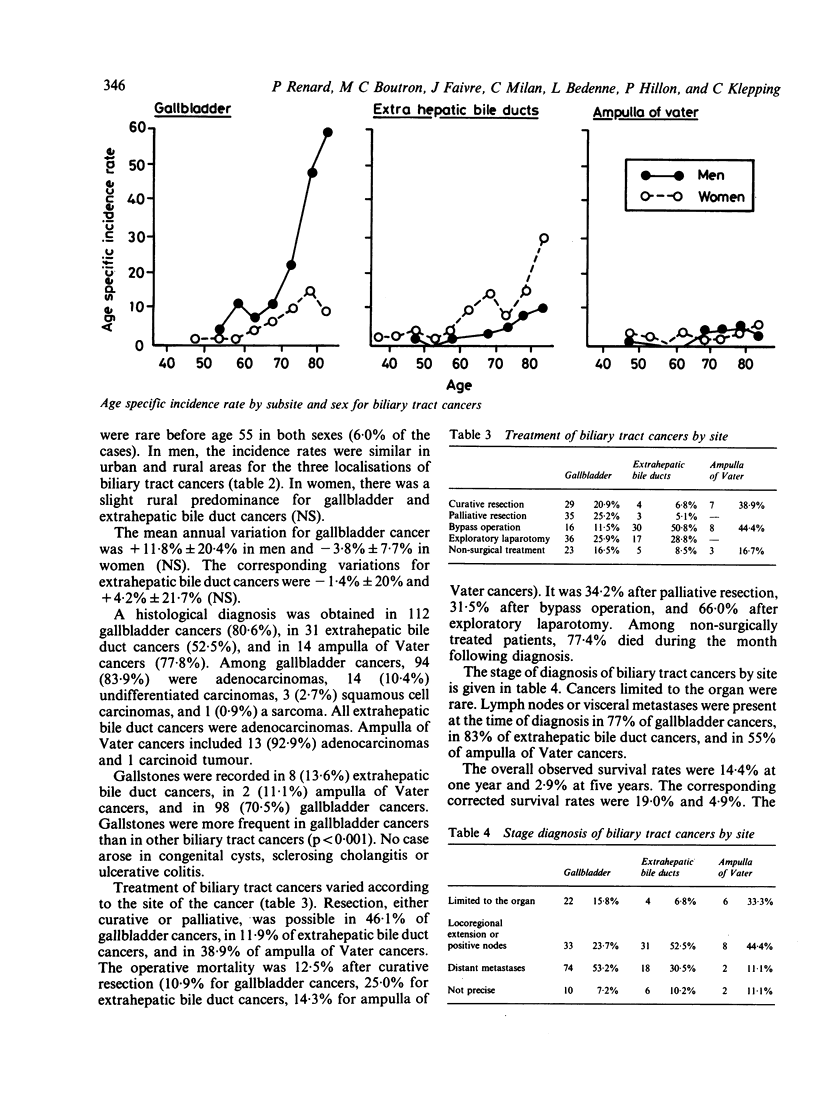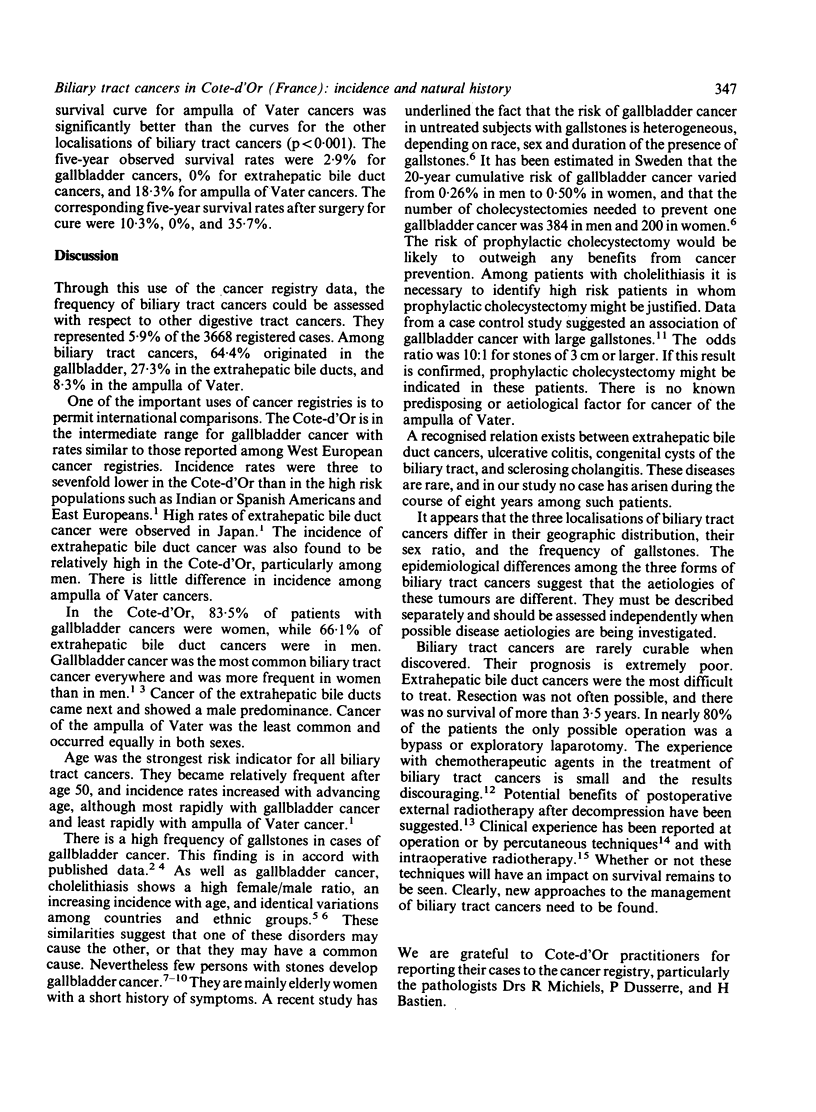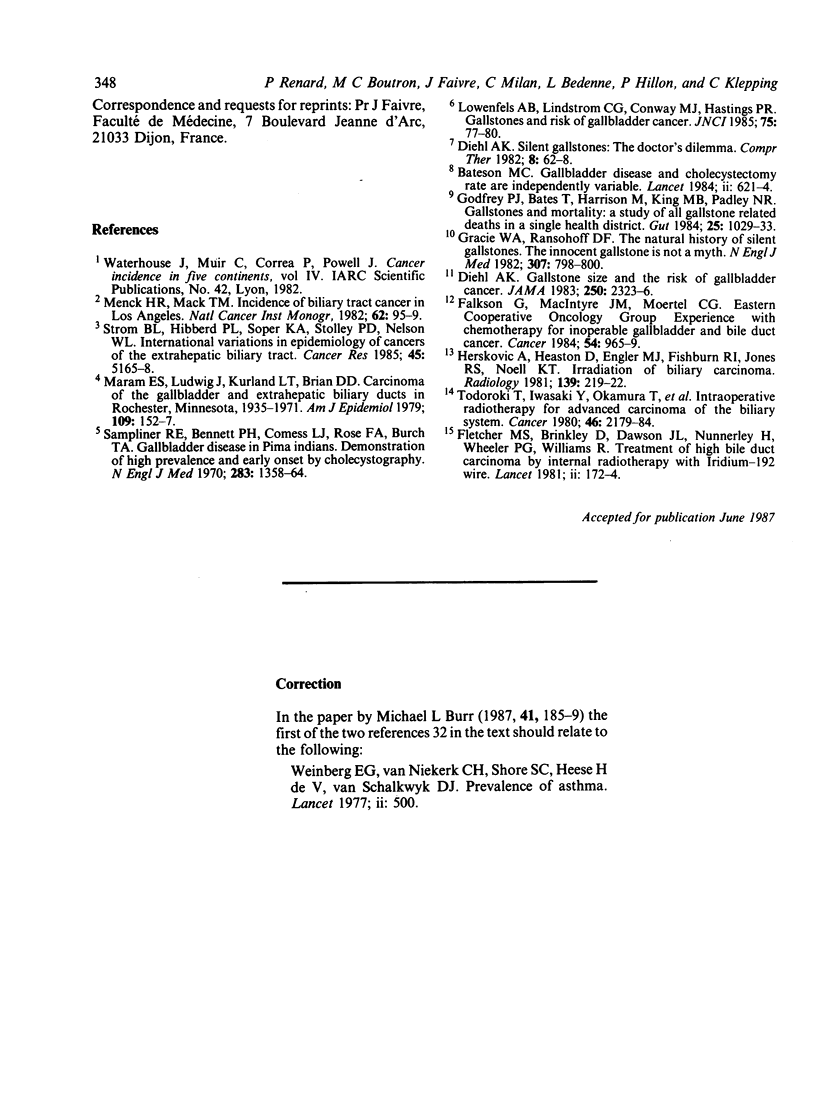Abstract
The registry of digestive tract tumours established for the department of Cote-d'Or (France) was used to study the epidemiological characteristics and the natural history of biliary tract cancers. Age standardised incidence rates for gallbladder cancers were 2.7/100,000 for women and 0.9/100,000 for men. The corresponding rates for extrahepatic bile duct cancers were 0.5/100,000 and 1.7/100,000, and for ampulla of Vater cancer 0.3/100,000 and 0.3/100,000. The three cancers differ in their descriptive epidemiology and should be considered separately in epidemiological analytical investigations. The incidence of each of the three diseases increased with age, and cancers of known histological type were mainly adenocarcinomas. Some gallbladder cancers were undifferentiated or squamous cell carcinomas. There was no significant variation in incidence for gallbladder cancer and extrahepatic bile duct cancer over the eight years of the study. The association with gallstones was frequent in gallbladder cancer: 70.5% compared to 13.0% in other biliary tract cancers (less than 0.001). Although the association of gallbladder cancer with gallstones is frequent, few patients with cholelithiasis experience development of a gallbladder cancer. It is necessary to identify among patients with gallstones a subgroup at high risk of gallbladder cancer in whom prophylactic surgery might be justified. Biliary tract cancers are seldom diagnosed early: lymph nodes or visceral metastases were present in 77% of gallbladder cancers, in 83% of extrahepatic bile duct cancers, and in 55% of ampulla of Vater cancers at the time of diagnosis. The corresponding resectability rates were 46.1%, 11.9%, and 38.9%. The five-year overall survival rates were 2.9% for gallbladder cancer, 0% for extrahepatic bile duct cancer, and 18.3% for ampulla of Vater cancer. The corresponding five-year survival rates after surgery for cure were 10.3%, 0%, and 35.7%. Biliary tract cancer still represent a great therapeutic challenge.
Full text
PDF




Selected References
These references are in PubMed. This may not be the complete list of references from this article.
- Bateson M. C. Gallbladder disease and cholecystectomy rate are independently variable. Lancet. 1984 Sep 15;2(8403):621–624. doi: 10.1016/s0140-6736(84)90605-6. [DOI] [PubMed] [Google Scholar]
- Diehl A. K. Gallstone size and the risk of gallbladder cancer. JAMA. 1983 Nov 4;250(17):2323–2326. [PubMed] [Google Scholar]
- Diehl A. K. Silent gallstones: the doctor's dilemma. Compr Ther. 1982 Aug;8(8):62–68. [PubMed] [Google Scholar]
- Falkson G., MacIntyre J. M., Moertel C. G. Eastern Cooperative Oncology Group experience with chemotherapy for inoperable gallbladder and bile duct cancer. Cancer. 1984 Sep 15;54(6):965–969. doi: 10.1002/1097-0142(19840915)54:6<965::aid-cncr2820540603>3.0.co;2-x. [DOI] [PubMed] [Google Scholar]
- Fletcher M. S., Brinkley D., Dawson J. L., Nunnerley H., Wheeler P. G., Williams R. Treatment of high bileduct carcinoma by internal radiotherapy with iridium-192 wire. Lancet. 1981 Jul 25;2(8239):172–174. doi: 10.1016/s0140-6736(81)90357-3. [DOI] [PubMed] [Google Scholar]
- Godrey P. J., Bates T., Harrison M., King M. B., Padley N. R. Gall stones and mortality: a study of all gall stone related deaths in a single health district. Gut. 1984 Oct;25(10):1029–1033. doi: 10.1136/gut.25.10.1029. [DOI] [PMC free article] [PubMed] [Google Scholar]
- Gracie W. A., Ransohoff D. F. The natural history of silent gallstones: the innocent gallstone is not a myth. N Engl J Med. 1982 Sep 23;307(13):798–800. doi: 10.1056/NEJM198209233071305. [DOI] [PubMed] [Google Scholar]
- Herskovic A., Heaston D., Engler M. J., Fishburn R. I., Jones R. S., Noell K. T. Irradiation of biliary carcinoma. Radiology. 1981 Apr;139(1):219–222. doi: 10.1148/radiology.139.1.7208926. [DOI] [PubMed] [Google Scholar]
- Lowenfels A. B., Lindström C. G., Conway M. J., Hastings P. R. Gallstones and risk of gallbladder cancer. J Natl Cancer Inst. 1985 Jul;75(1):77–80. [PubMed] [Google Scholar]
- Maram E. S., Ludwig J., Kurland L. T., Brian D. D. Carcinoma of the gallbladder and extrahepatic biliary ducts in Rochester, Minnesota, 1935--1971. Am J Epidemiol. 1979 Feb;109(2):152–157. doi: 10.1093/oxfordjournals.aje.a112670. [DOI] [PubMed] [Google Scholar]
- Sampliner R. E., Bennett P. H., Comess L. J., Rose F. A., Burch T. A. Gallbladder disease in pima indians. Demonstration of high prevalence and early onset by cholecystography. N Engl J Med. 1970 Dec 17;283(25):1358–1364. doi: 10.1056/NEJM197012172832502. [DOI] [PubMed] [Google Scholar]
- Strom B. L., Hibberd P. L., Soper K. A., Stolley P. D., Nelson W. L. International variations in epidemiology of cancers of the extrahepatic biliary tract. Cancer Res. 1985 Oct;45(10):5165–5168. [PubMed] [Google Scholar]
- Todoroki T., Iwasaki Y., Okamura T., Nagoshi K., Asakura H., Nakano M., Inada T., Tsunemoto H., Umegaki Y., Nishimura A. Intraoperative radiotherapy for advanced carcinoma of the biliary system. Cancer. 1980 Nov 15;46(10):2179–2184. doi: 10.1002/1097-0142(19801115)46:10<2179::aid-cncr2820461014>3.0.co;2-y. [DOI] [PubMed] [Google Scholar]


